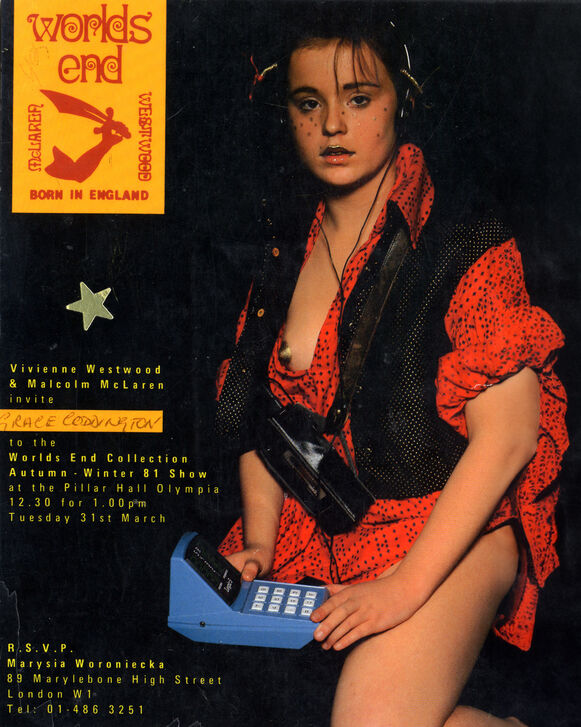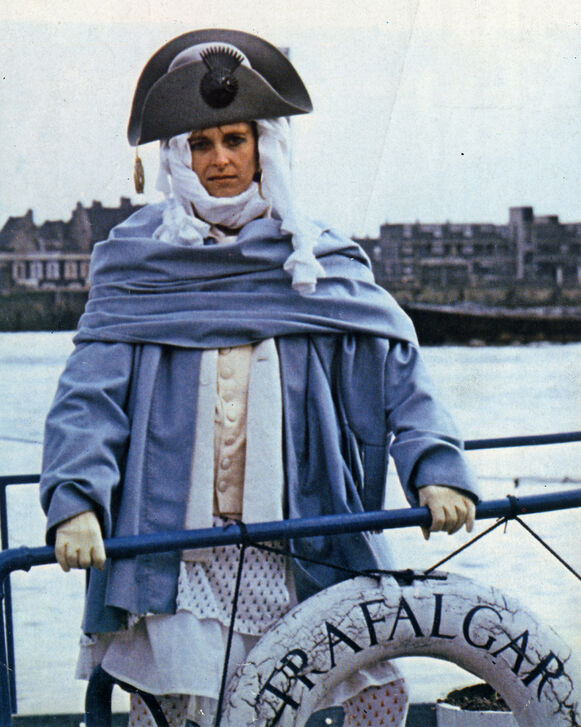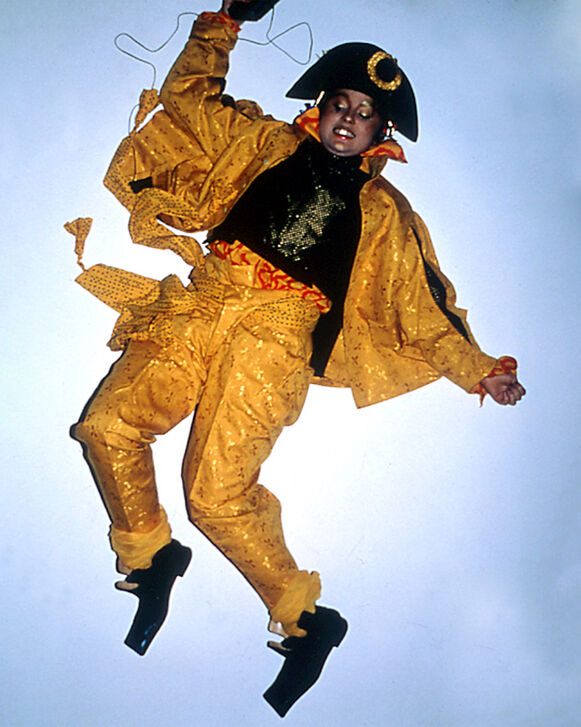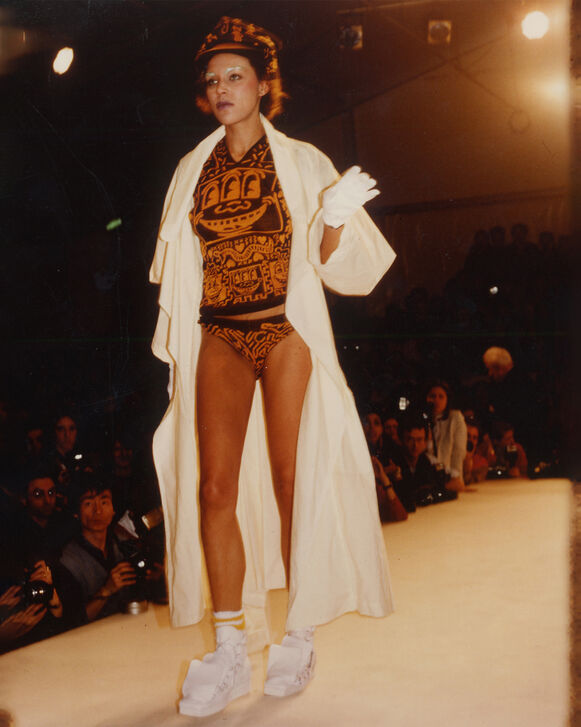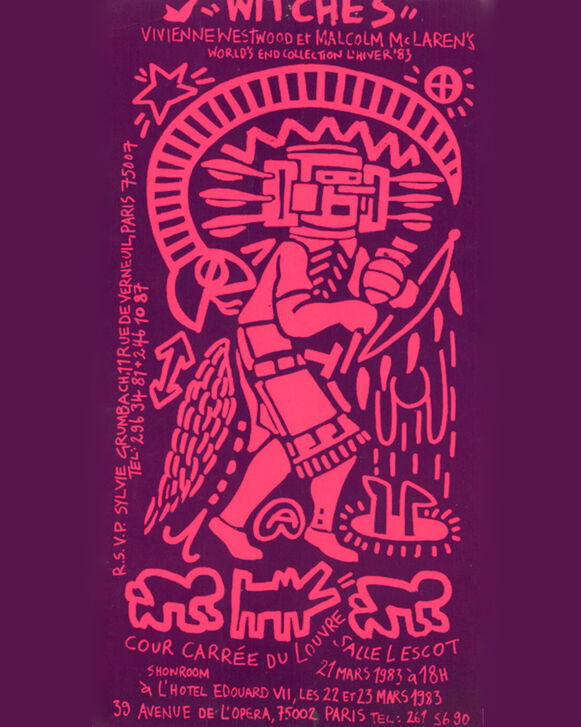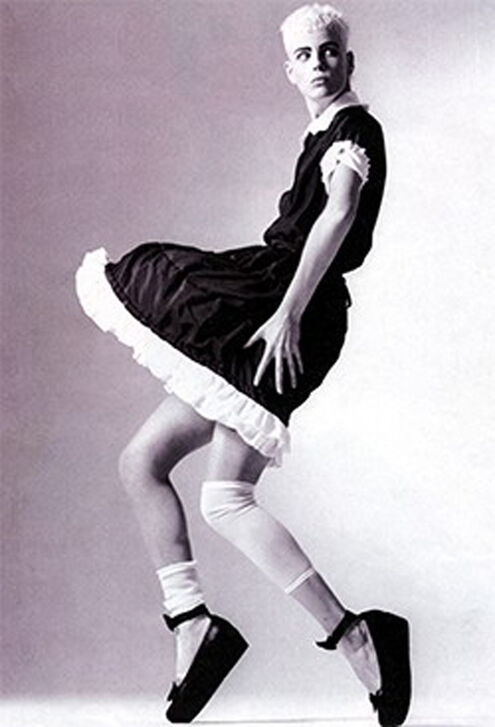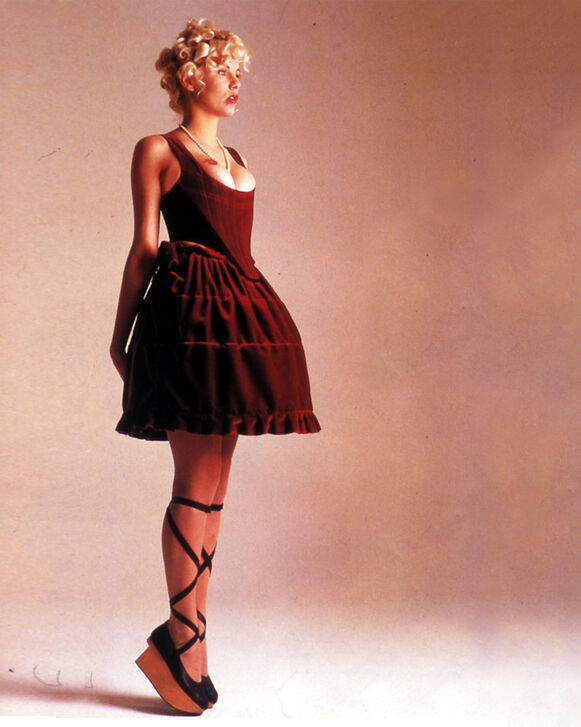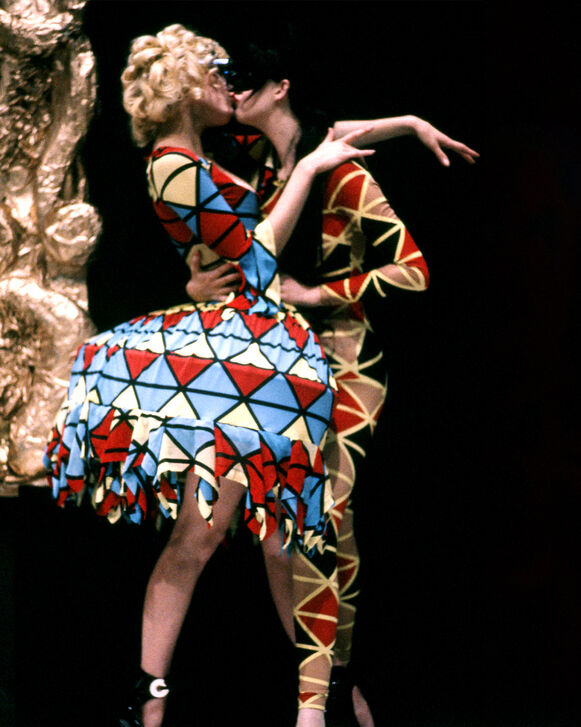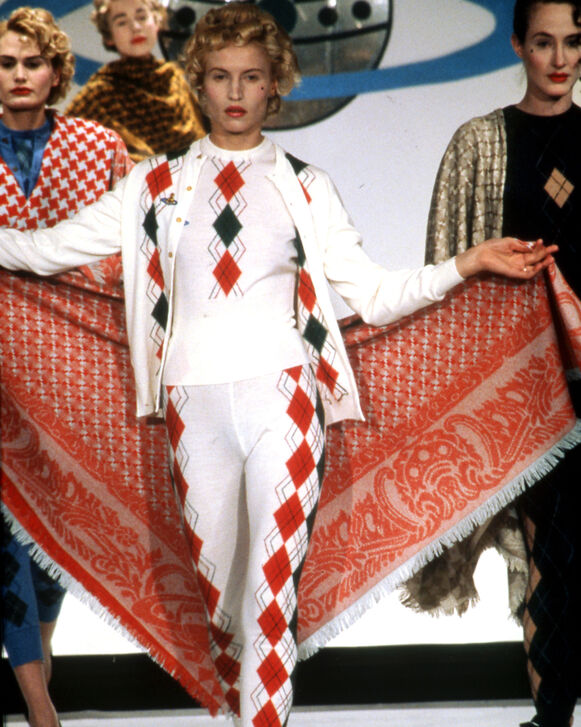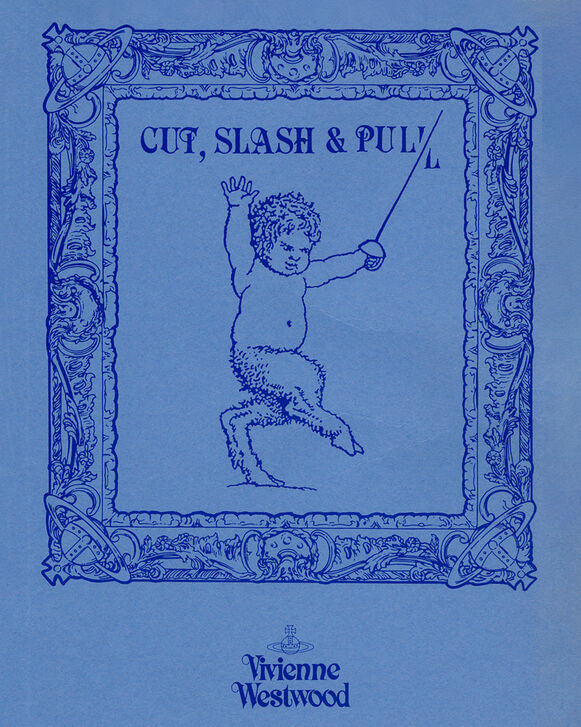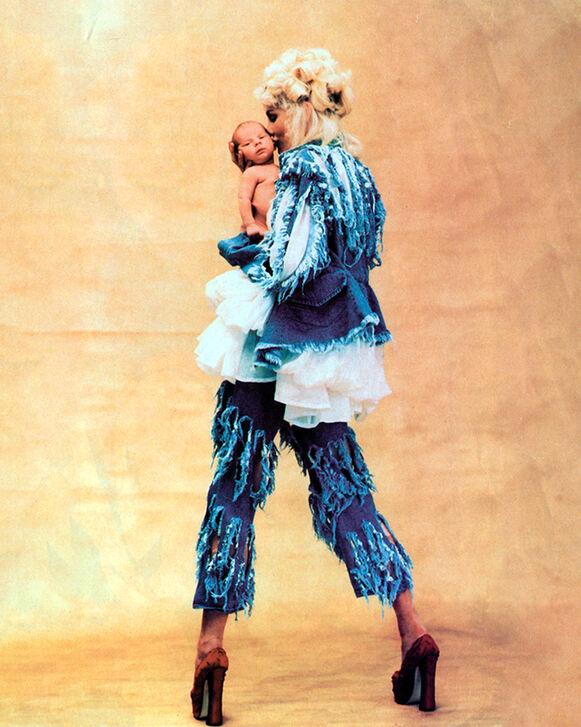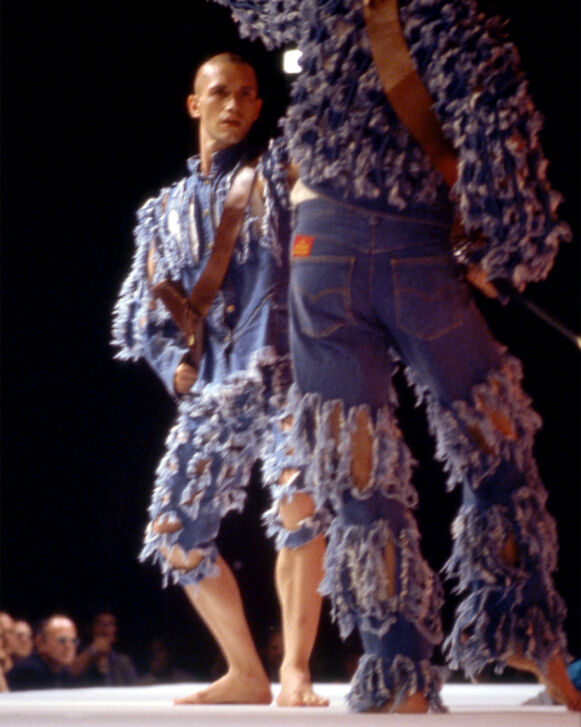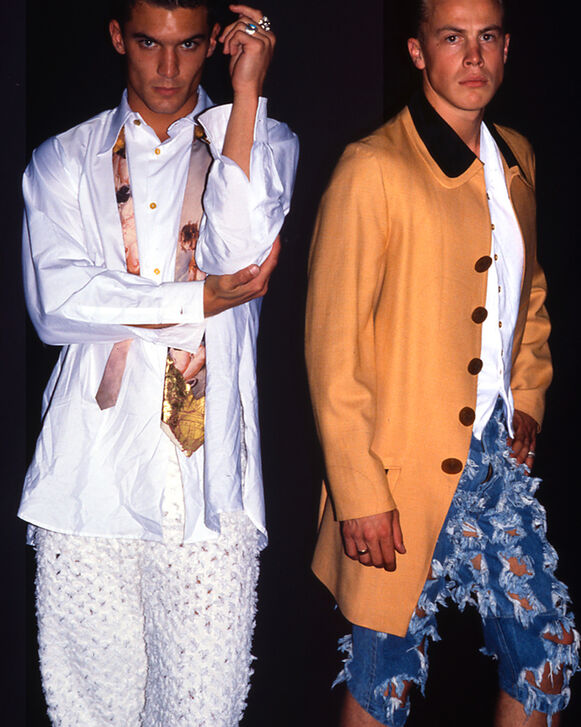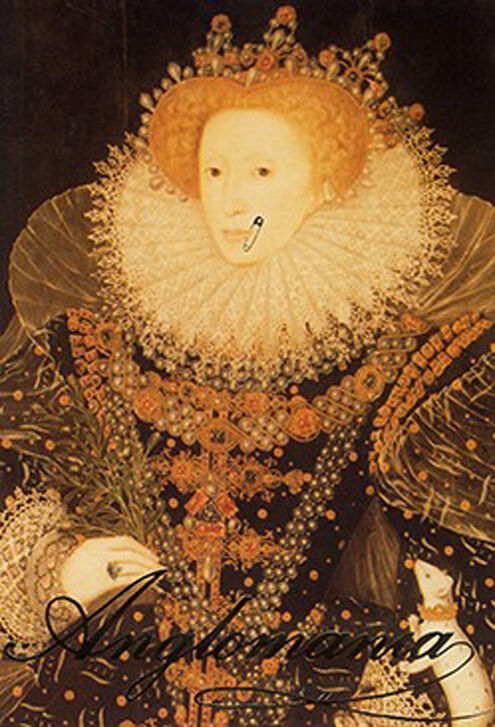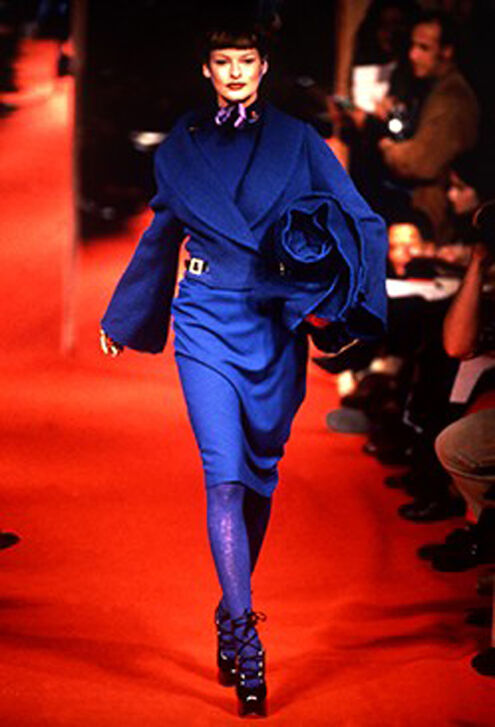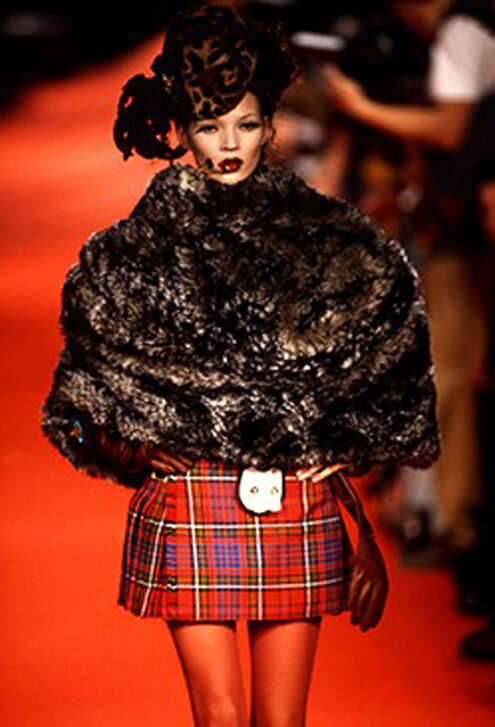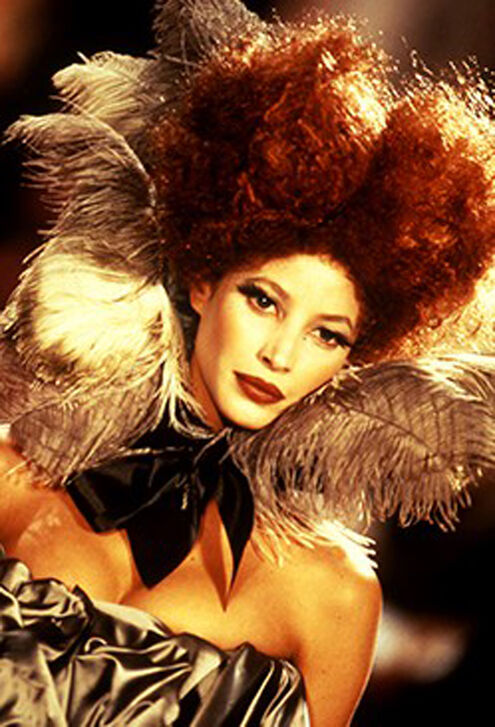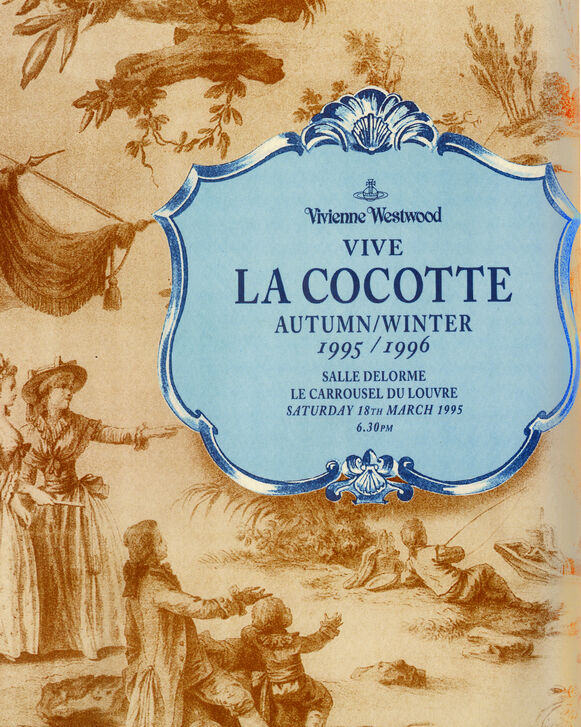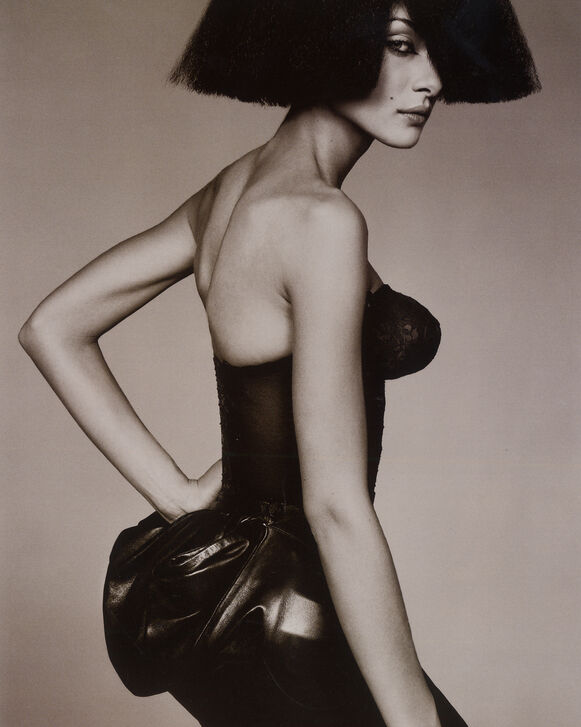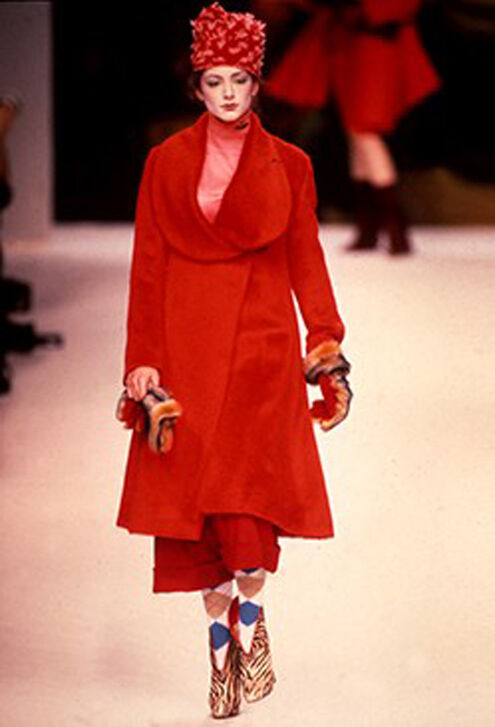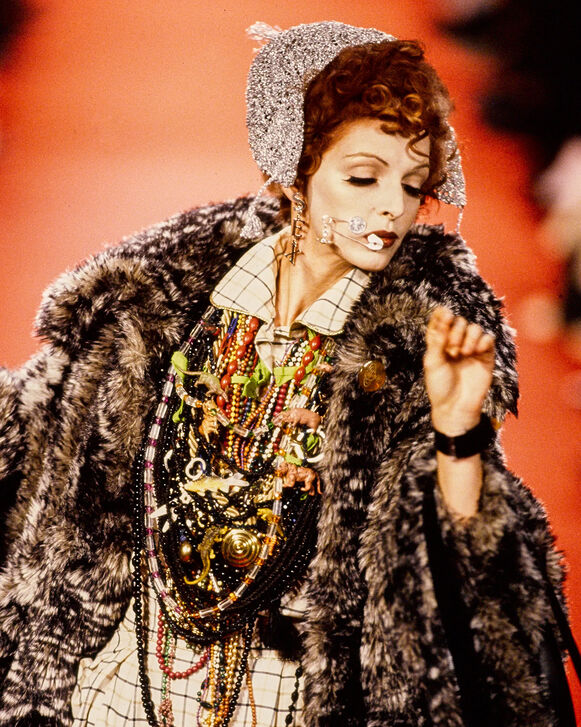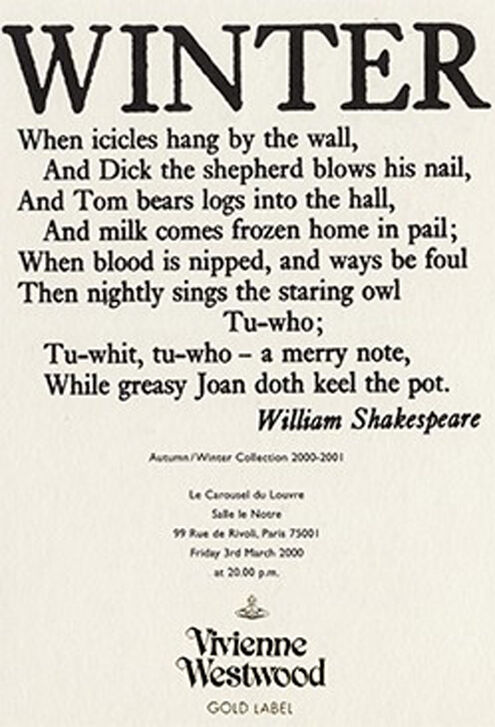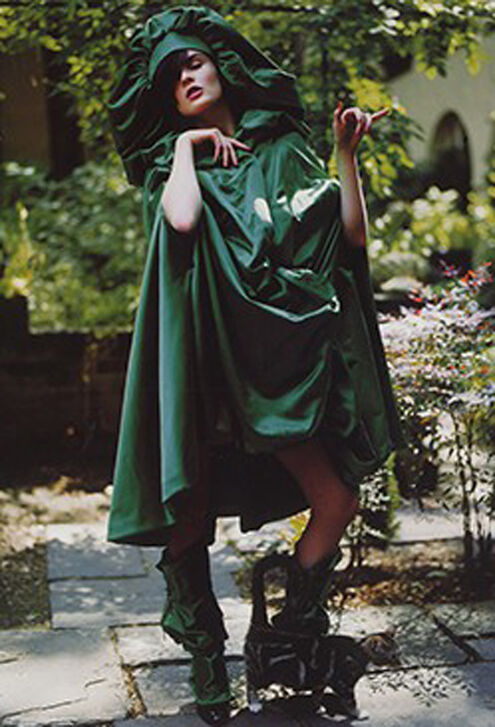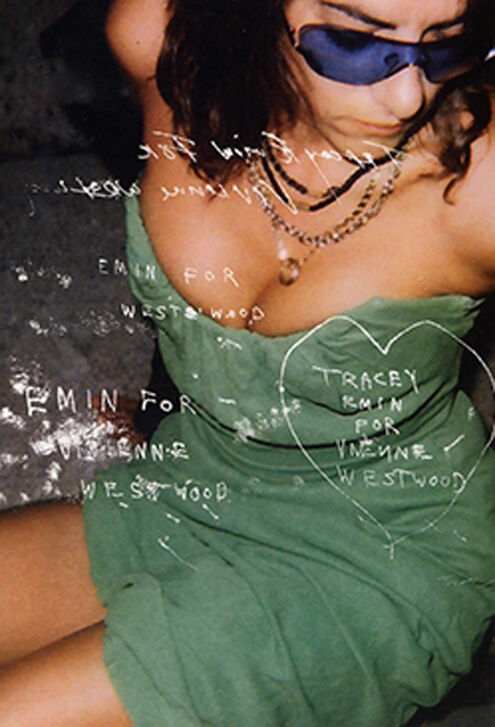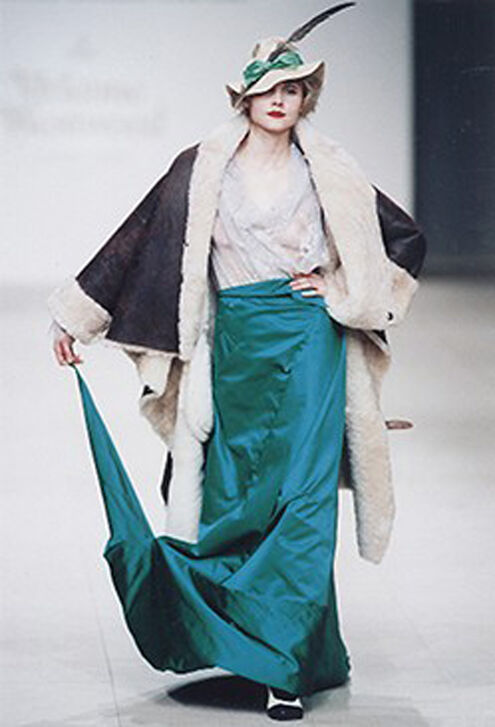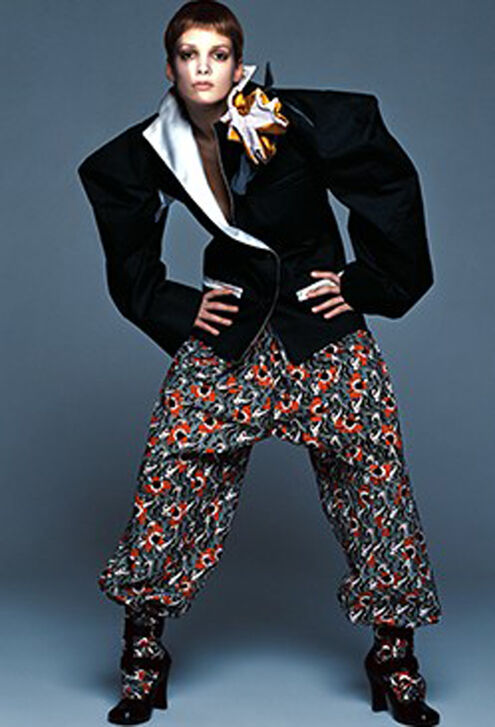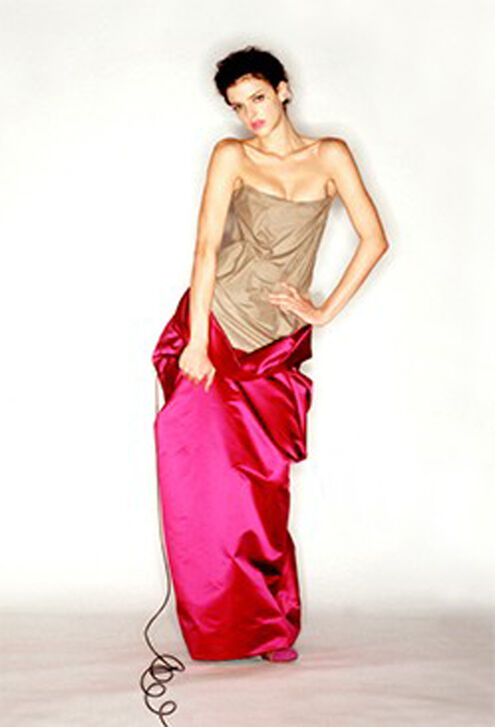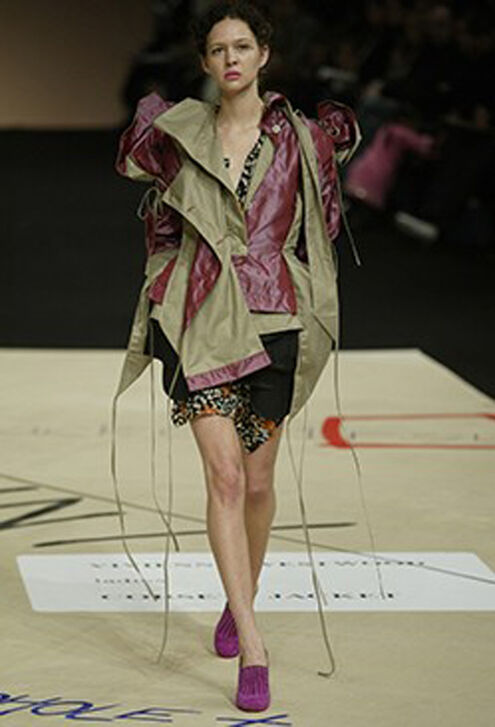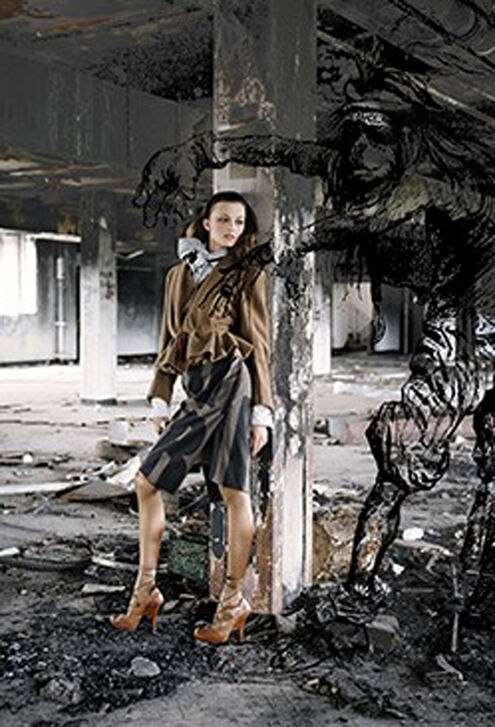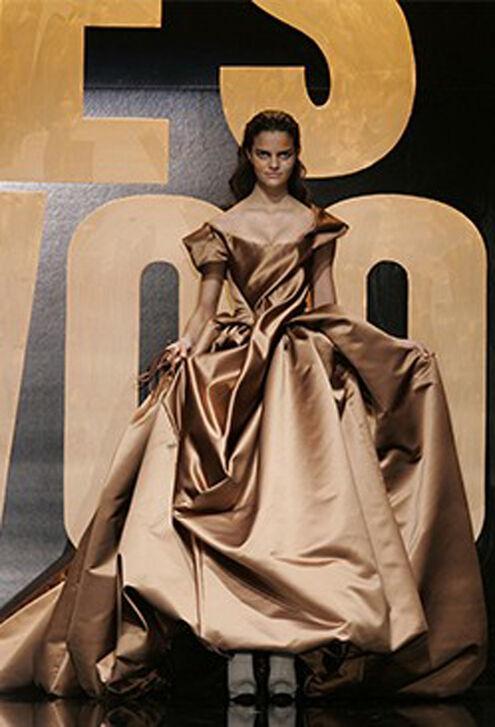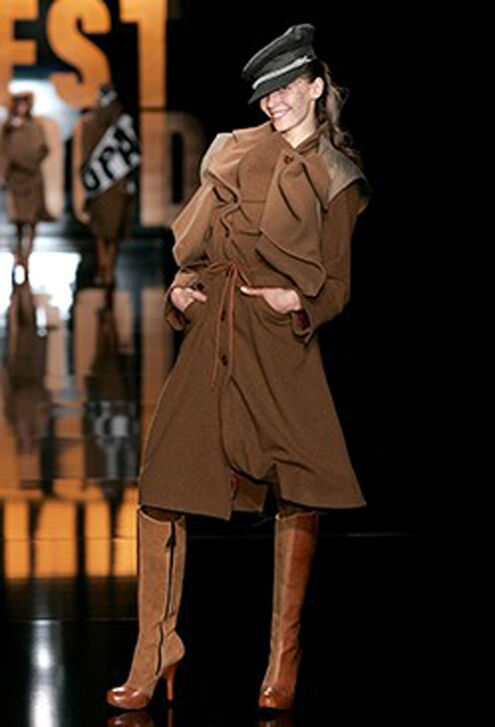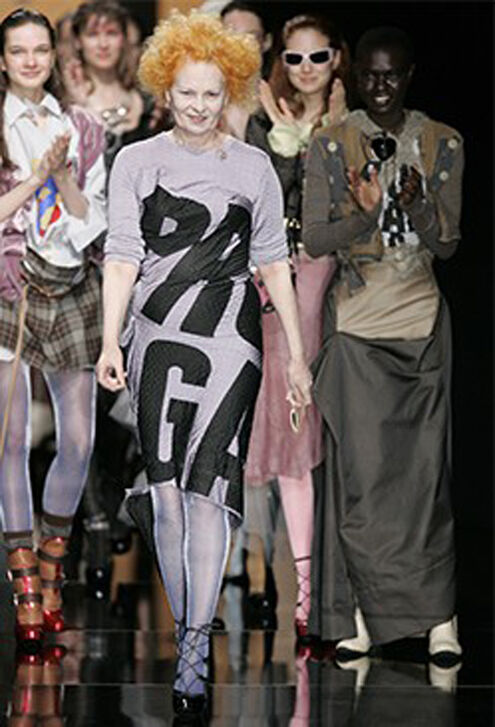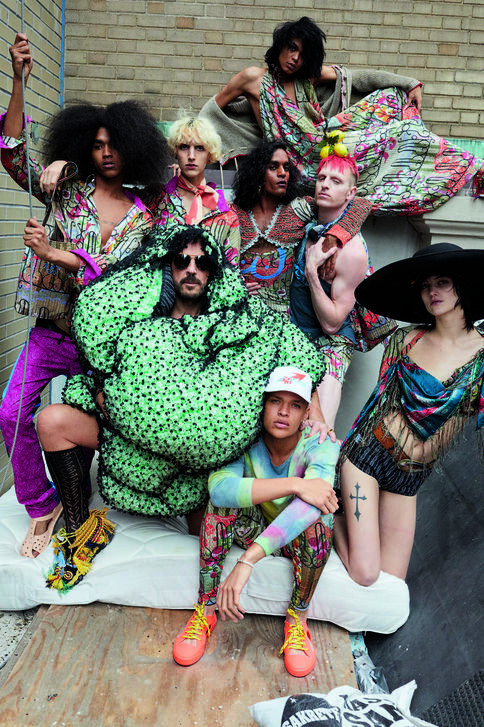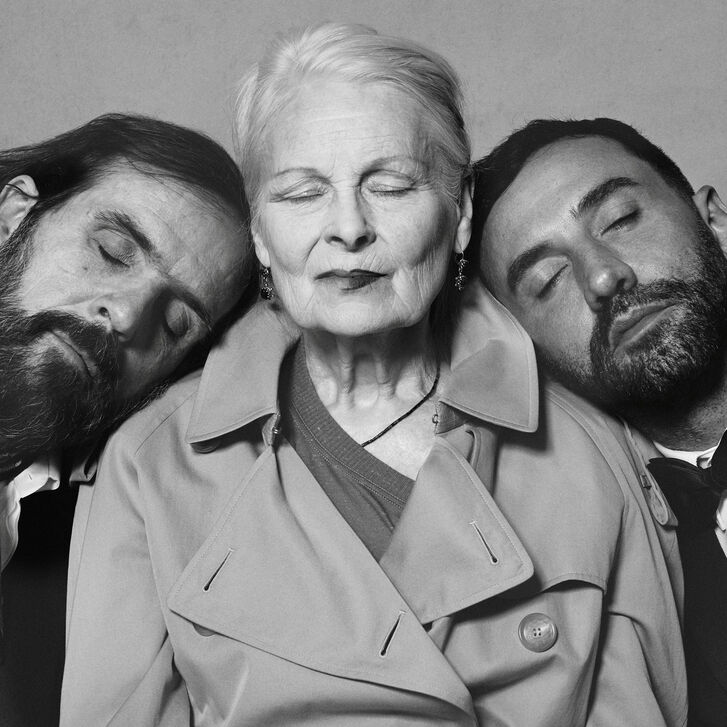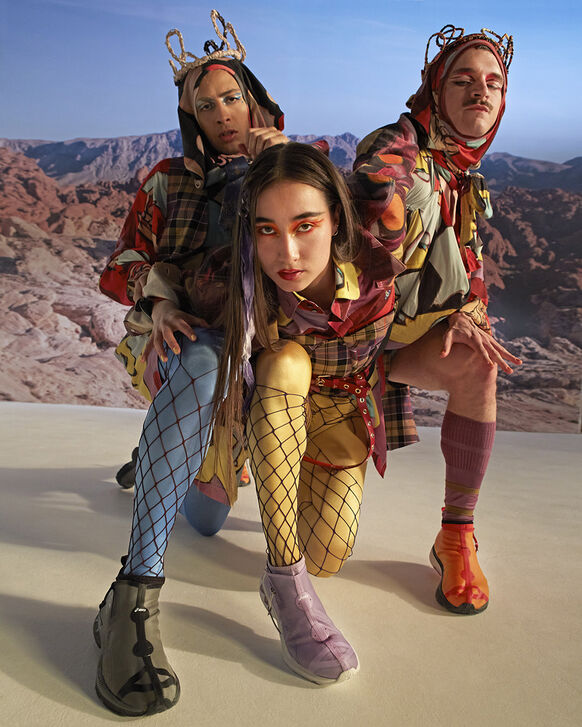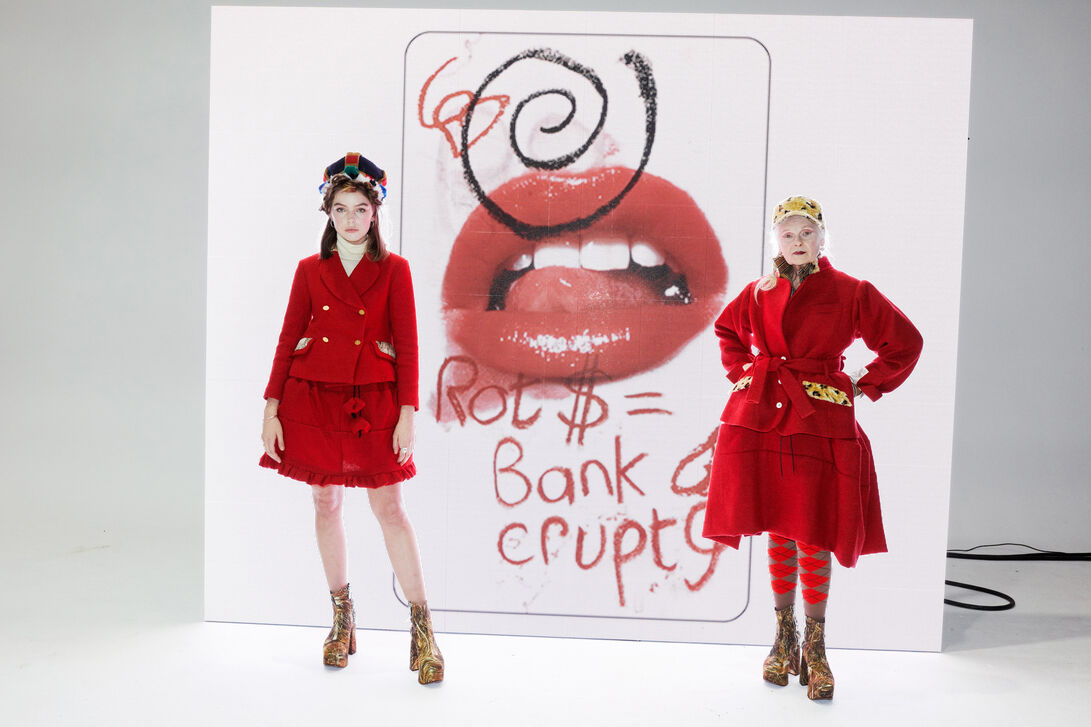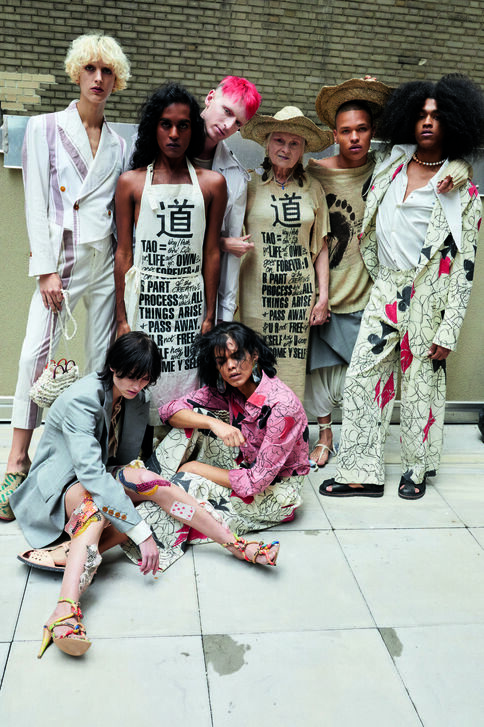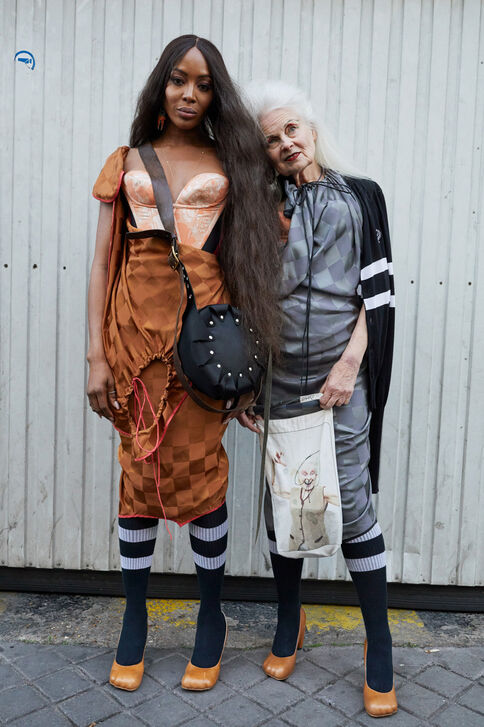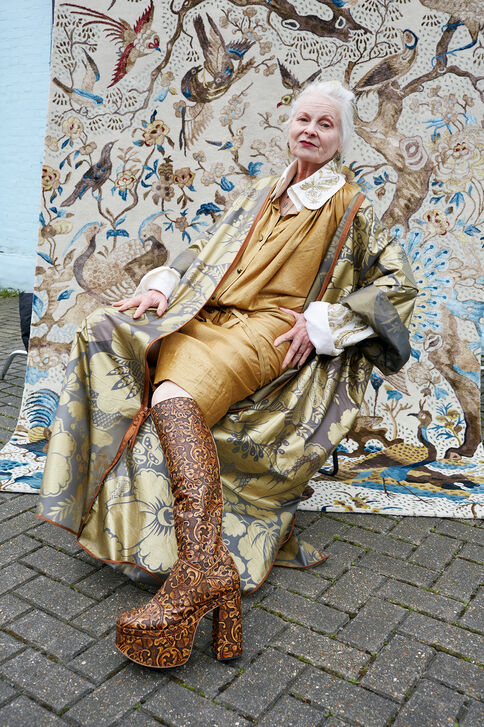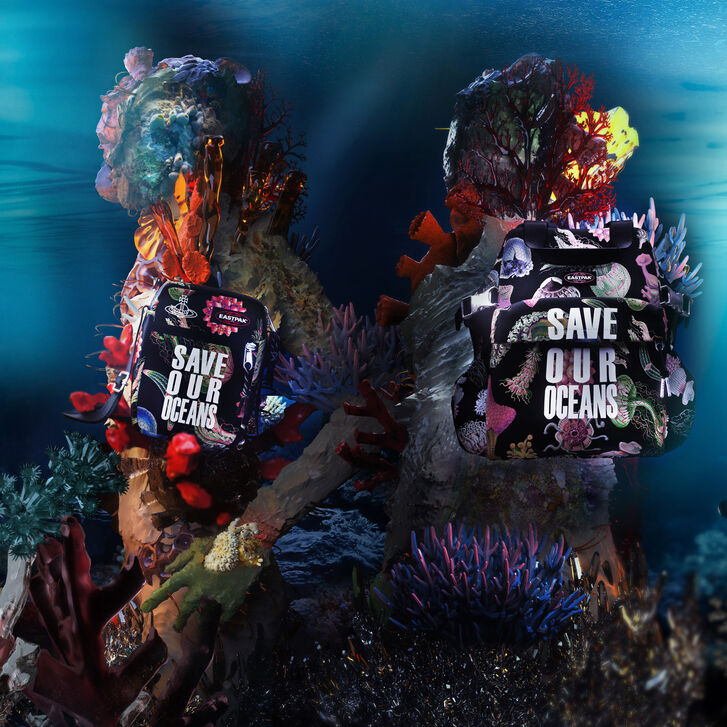Westwood World
The Story so Far
—
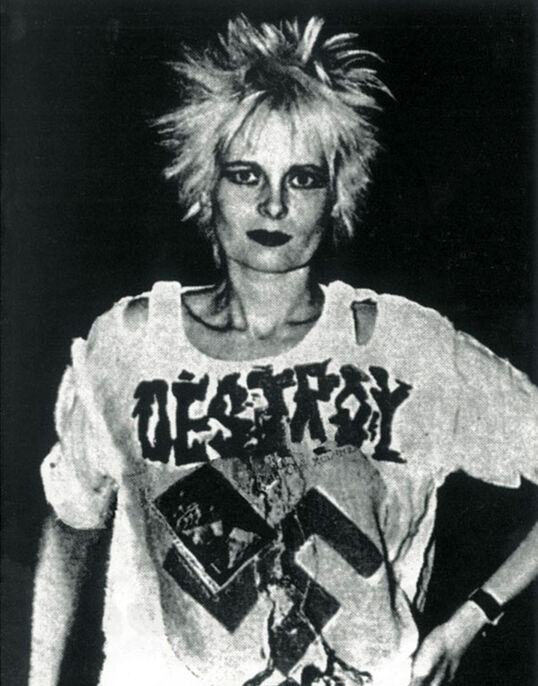
430 Kings Road
1971 – 1980
The hippie movement was the most popular fashion in late 1960s London, but it didn’t inspire young Vivienne Westwood and Malcolm McLaren. They were much more intrigued by acts of rebellion and typical 1950s clothing, music, and memorabilia.
Vivienne began by designing and making Teddy Boy clothes for Malcolm and in 1971 they opened a small boutique called Let it Rock at number 430 Kings Road, Chelsea in London.
A year later, Vivienne’s interests had turned to biker clothing, zips, and leather. The shop re-branded with a skull and crossbones and was renamed Too Fast to Live, Too Young to Die.
Vivienne and Malcolm began to design their own t-shirts with provocative printed slogans, which led to their prosecution under the 1959 Obscene Publications Act; they responded by re-branding the shop once again and producing even more t-shirts featuring hard-core images.
By 1974 the shop was renamed Sex, a shop “unlike anything else going on in England at the time” they used the slogan ‘rubberwear for the office’.
Two years later, popular band the Sex Pistols’ (managed by Malcolm) song ‘God Save the Queen’ went to number one in the charts but was refused airtime by the BBC. The shop reopened as Seditionaries, transforming the straps and zips of obscure sexual fetishism and bondage into fashion, and inspiring a D.I.Y. aesthetic. The mass media labelled this as ‘Punk Rock’.
The collapse of the Sex Pistols and the adoption of punk by the mainstream left Vivienne disenchanted. In 1980 the shop was refitted and renamed Worlds End, which is still the name that’s in use today.
The shop’s basement was formerly a restaurant, but Worlds End eventually absorbed it to expand the stockroom and staff facilities. Officially the shop hasn’t changed aesthetically since opening its doors. The original interior was restored in 2017, but all details remain as they were designed by Vivienne and Malcolm 40 years ago.
Vivienne used her creations to communicate ideas – often using graphics to confront issues of political and social injustice. The swastika symbol seen on the 1977 Anarchy Shirt, designed by Westwood & McLaren, was laid over an inverted image of Christ on the crucifix and Queen Elizabeth II on a British stamp, with the word 'DESTROY' emblazoned above the image. The graphics were meant as a provocative act of denouncing corruption and dictatorship. More broadly, it was a meant as a means to challenge the older generation, of saying “We don’t accept your values or your taboos - you’re all fascists.”
The Early Years
1981 – 1987
In 1984 the Nostalgia of Mud shop (now known as Worlds End) closes in West London and Vivienne relocates to Italy.
Vivienne receives an invitation to show her Spring-Summer 1984 ‘Hypnos’ collection in Tokyo at Hanae Mori’s ‘Best of Five’ global fashion awards, with Calvin Klein, Claude Montana, and Gianfranco Ferre.
Vivienne Westwood opens another London boutique on Davies Street in 1988.
In 1986 the orb logo was first used to symbolize taking tradition into the future.
Carlo D’Amario was appointed Managing Director of Vivienne Westwood Ltd in 1986.
The 1981 ‘Pirate’ Collection was Vivienne Westwood and Malcolm McLaren’s first official collaborative catwalk show. It informed the aesthetic of The Worlds End Boutique with its pirate’s galleon and ship features. This collection was filled with romantic looks in gold, orange, and yellow which burst onto the London fashion scene, ensuring its place in the house’s history of influence.
‘We’ve only stopped to note significant innovations, otherwise, the ideas carry through and develop throughout the collections.’ ‘Pirate’, Autumn-Winter 1981/82 was their first catwalk show. Looking at plundering history and the Third World. The research was into historical dress, keeping the original cuts as fashion. Inspired by Native American patterns, the ‘Pirate’ trousers had a baggy bum, in complete contrast to hippy hipsters and ‘tight arses’ of the time. The position of the neck when worn, was asymmetrical.
At this pivotal point in her career, Vivienne reimagined techniques based on traditional rectangular cuts. She had an idea she knew would work, knocked it up in rough and on a small scale, and tried it out on a little dummy. Through various adjustments and fittings, she arrived at a full-scale finished garment in the right fabric. Clothes always have a dynamic with the body. She continues to mix this in with historical cuts.
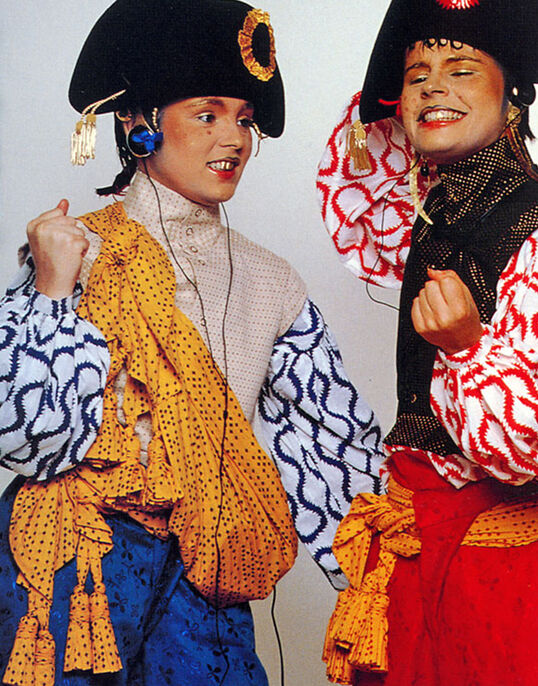
Collections:
Savage, Spring-Summer 1982 – Flat cutting from Japan. – Inspired by: Matisse and Picasso. – “In taking from other cultures I’m just doing what Picasso did in his painting Demoiselles d’Avignon’” (Vivienne) – Examines rapport between clothes and the body. – Slashed sleeves and contrast linings. – David Lynch’s ‘The Elephant Man’ inspired foreign legion hats.
Buffalo Girls (Nostalgia of Mud), Autumn-Winter 1982/83 – Colours: Mud. – Raw cut sheepskin. – Bras – underwear as outerwear. – Inspiration: Peruvian women wearing bowler hats and full skirts, dancing with their babies tied on their back.
Punkature, Spring-Summer 1983 – Inspiration: ‘Blade Runner’, desert landscape. – Distressed fabric and recycled junk. – Punk and couture. – Hand-dyed, hand-stitched. – Shoes of disused tyres and cord from favelas. – Giant tin can buttons. – The jersey Tube skirt.
Witches, Autumn-Winter 1983/84 – Visit to New York, met Keith Haring. His art looked like magic signs and hieroglyphics. Therefore – collection “Witches”. – Hip Hop, styling of garments. – Stop-frame look. – White trainers customised with three tongues. – Pointed Chico Marx hats.
Hypnos, Spring-Summer 1984 – Image: Greek God of Sleep – Collection nothing to do with sleep. – Very active, sportswear as high fashion. – Collaboration with Malcolm McLaren ceased. – Made in Italy. – Inspiration: gay subcultures. – Herpes sores makeup.
Clint Eastwood, Autumn-Winter 1984/85 – Vivienne said, “Sometimes you need to transport your idea to an empty landscape and then populate it with fantastic looking people.” – Fluorescent big macs and body stockings, clothes covered in company logos. – Day-Glo patches inspired by Tokyo’s neon signs.
Mini-Crini, Spring-Summer 1985 – Cardinal change. Fitted clothes. – English tailoring. Princess line coats, inspired by the Queen as a child. – Wish to kill masculine big shoulders of the 1980s. – Models are sexy, and curvaceous. – Attention drawn to hips. – Inspiration: Petrushka. – Rocking horse shoes.
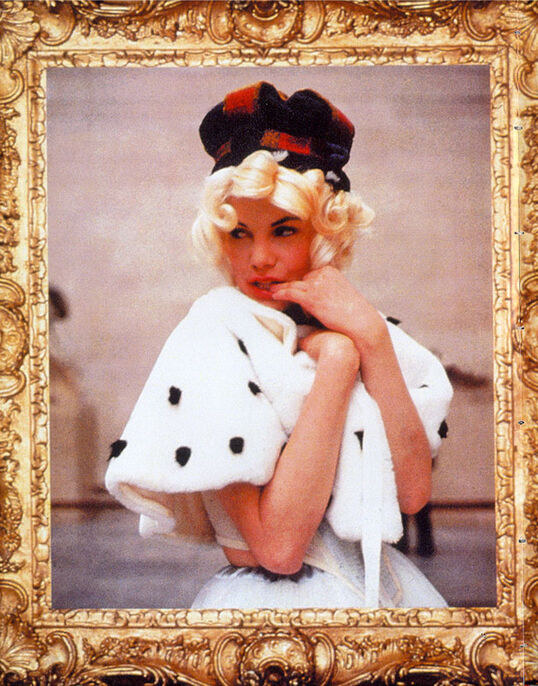
The Pagan Years
1988 – 1992
John Fairchild’s 1989 book ‘Chic Savages’ features Vivienne in a list of the world’s top six designers along with Armani, Lagerfeld, Saint Laurent, Lacroix and Ungaro.
Vivienne is appointed as Professor of Fashion at the Vienna Academy of Applied Arts from 1989 to 1991.
In December 1990, the Davies Street boutique opens in London’s Mayfair.
Vivienne receives an award for Fashion Designer of the Year for two years in a row in 1990 and 1991 by the British Fashion Council.
Vivienne receives an O.B.E at Buckingham Palace from her Majesty Queen Elizabeth ll in 1992.
Vivienne introduces wedding gowns into her collections in 1992.
In 1992, Vivienne is made an Honorary Senior Fellow of the Royal College of Art (RCA).
Vivienne marries Andreas Kronthaler in 1993, whom she met in 1988 whilst teaching in Vienna.
During this period Vivienne’s heroes shifted from punks and ragamuffins to ‘Tatler’ girls wearing clothes that parodied the upper class. A chance encounter inspired one of her most important and influential collections, Autumn-Winter 1987 ‘Harris Tweed’. “My whole idea for this collection was stolen from a little girl I saw on the tube one day. She couldn’t have been more than 14. She had a little plaited bun, a Harris Tweed jacket, and a bag with a pair of ballet shoes in it. She looked so cool and composed standing there.”
Collections:
Harris Tweed, Autumn-Winter 1987/88 – Tailored and childish look inspired by Royal Family continued. – Inspiration: British fabrics, especially wool which had provided all the uniforms of the British Empire. – Black velvet. – 18th-century corsetry. – Fine twin sets. – Red Barathea Mini-Crini.
Britain Must Go Pagan, Spring-Summer 1988 – Mythological, Greco-Roman themes. – Titled ‘England Must Go Pagan’ on invitations. – Exploring the 18th and 19th century ‘Age of Enlightenment’. – Referencing the literature of Ancient Greece and Rome. – Typically structured pieces, tailored, narrow proportions with cropped torsos.
Time Machine, Autumn-Winter 1988/89 – Named after H.G Wells’ novella. – Oscillating through different eras – Tailored Harris Tweed suiting. – First reference of the Wallace Collection. – Examining British culture and tradition. – Dedicated to Agatha Christie’s Miss Marple. – Men in Norfolk jackets.
Civilizade, Spring-Summer 1989 – Fashion as a didactic tool. – A modern society. – Armoured jackets, rugby jerseys, and harlequins. – Inspiration: mythological beasts. – Blown-up animal print appears for the first time.
Voyage to Cythera, Autumn-Winter 1989/90 – Inspiration: Watteau, Commedia dell’ Arte and Ballets Russes. – Tights worn without skirts. Inspiration: a man who forgot his trousers.- Classic nudity and ancient sculpture. – Homeric themes.
Pagan V, Spring-Summer 1990 – Invitation matched penis sketched underwear. – Exploring philosophies of Hellenistic Greece. – Sailor hats at an angle. – Pinstripes in abundance. – H.M.S ARGO print. – Pyjama suits. – Inspiration: Vases in the Louvre. – Lampshade wiring.
Portrait, Autumn-Winter 1990/91 – Inspiration: Oil painting – the bravura of texture and display of material wealth – Wish to have the luxury of the whole range of fabric from linen underwear to fur (fake). – Furniture designed by Boulle in the Wallace Collection. – Painting by Boucher, ‘Shepherd watching a Sleeping Shepherdess’, to represent the paintings themselves – photographic print. – High platform shoes put the woman on a pedestal like she had stepped out of a painting.
Cut and Slash / Pitti Uomo, Spring-Summer 1991 – Slashed fabric – satin, cotton, denim. – Inspiration: 16th and 17th century mania for cutting and slashing fabric, lasted for 200 years, apparently inspired by a battle. – Codpiece revival. – Swashbuckling down the catwalk. – Broderie Anglaise programme. – Chunky hand-knits.
Dressing Up, Autumn-Winter 1991/92 – Overt Maximalism. – Reimagining tropes and signatures. Boulle patterns. – First collaboration with milliner Prudence. – Figure-hugging versus extremely oversized. – Extended hemlines. – Leather Codpiece skirts.
Salon, Spring-Summer 1992 – The boundaries of gender. – Photographic prints of 18th century lavishness on denim. – Inspiration: elitism and the intellectual’. – Berets and smocks. – Tulle ball gowns. – Cut-out leather.
Always on Camera, Autumn-Winter 1992/93 – Inspiration: 1930’s Hollywood. – Movie star stereotypes. – Storytelling with clothes. – Juxtaposing the Great Depression and recession. – Marlene Dietrich as muse, shared Teutonic background with Andreas Kronthaler. – Stature of Liberty corset. – Padded mohair knitwear. – Models as actors.
Anglomania
1993 – 1999
Vivienne Westwood collaborates with Swatch to create the ‘Putti’ and ‘Orb’ watches in 1992/93.
A new boutique opens at 43 Conduit Street, in central London.
Vivienne is appointed Professor of Fashion at the Berliner Hochschule der Künste in 1993.
Vivienne channelled her creative nature into producing her own tartan for the ‘Anglomania’ Autumn-Winter 1993/94 collection and invented her own clan, MacAndreas. The Lochcarron of Scotland officially recognized the clan, which is a process that normally takes 200 years, a huge achievement for Vivienne.
A three-part Channel 4 series, Painted Ladies, was broadcast in 1996 examining the relationship between fashion and art. Vivienne looked at the costumes depicted in the art of the classical, mediaeval and renaissance periods.
Vivienne Westwood opens a new boutique at 44 Conduit Street, London in 1997.
Vivienne Westwood’s debut fragrance ‘Boudoir’ launches in 1998. It was developed in conjunction with world-famous ‘nose’, Martin Gras of Dragoco. “My perfume is called Boudoir. A boudoir is a dressing room and a place to get undressed. It signifies a woman’s space, a place where she is on intimate terms with herself, where she sees her faults and her potential” (Vivienne).
Vivienne Westwood Red Label launches in 1999. The prêt-à-porter line combines Vivienne’s continued interest in Savile Row tailoring and French couture.
The first Vivienne Westwood New York boutique opens in 1999.
The Vivienne Westwood MAN label launches in 1996 in Milan.
A Vivienne Westwood licensed boutique launches in Tokyo, Japan, a first outside of the UK.
‘Anglomania’ launches in 1998 as its own diffusion line, taking inspiration from the Vivienne Westwood archive collections. The youthful collection pays homage to Vivienne's iconic tailoring and draped silhouettes and includes styles from the SEX, Pirate, Mini-Crini and Bondage collections.
Vivienne believes that fashion is a combination and exchange of ideas between France and England; “On the English side we have tailoring and an easy charm, on the French side that solidity of design and proportion that comes from never being satisfied because something can always be done to make it better, more refined.”
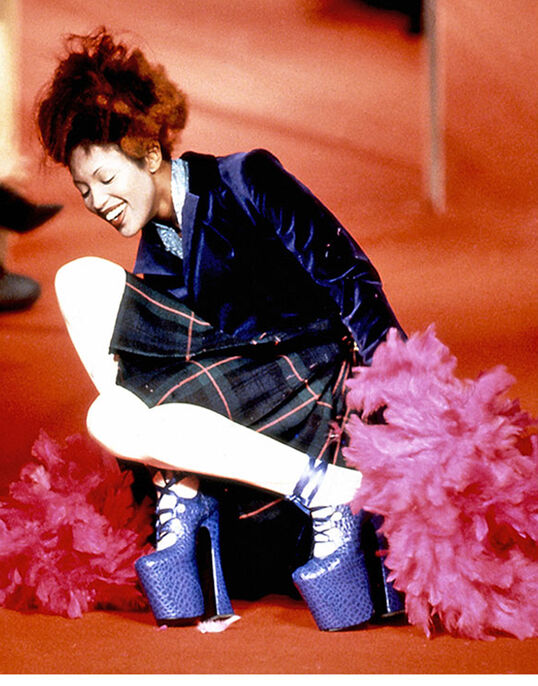
Collections:
Grand Hotel, Spring-Summer 1993 – In reference to the 1932 Greta Garbo film. – Full skirted ball gowns become a Vivienne Westwood motif. – Hotel lobby rendezvous’. – Pyjama collars. – Vivienne models for the first time. – Endangered animal print. – Inspiration: Saint Laurent and Dior shapes. – Long ‘Circle’ skirt. – Grey suit was worn by Vivienne when receiving her OBE.
Anglomania, Autumn-Winter 1993/94 – At the time of Gainsborough the French became mad about English tailoring and the spontaneity of country charm. – The corset as the foundation for an evening dress. – Patriotism. – French Art through an English lens. – Affinity for European culture. – Naomi Campbell’s tumble in Elevated Ghilli heels. – Stout tweed. – Commissioning of the MacAndreas tartan as a tribute to her husband. – Vivienne Westwood Gold Label was born. – Double-breasted suits. – Woollen capes.
Café Society, Spring-Summer 1994 – Cafes as a continuation of Salons. – A homage to Charles Frederick Worth, the 19th-century founder of French Haute Couture. – The hourglass figure began here with a bustle provided by a cushion. – By this time the volume of the gowns and their trains had reached maximum proportions due to collaboration with Andreas Kronthaler. – Crinoline gowns. – Knitted tassels. – Topless Kate Moss in a micro-mini skirt.- Layered faux furs.
On Liberty, Autumn-Winter 1994/95 – Emphasis on individual freedom, inspired by: English philosopher John Stuart Mill. – “Couture must exist alongside mass production” (Vivienne). – Reset of modern proportions. – Bum pads. – Distortion of proportion. – London department store Liberty prints. – Championing the voluptuous female form.
Erotic Zones, Spring-Summer 1995 – Extreme silhouettes. – Women as heroic figures. – Reminding audiences of the power of female sexuality. – ‘Cul cage’ wire bustle was created by Andreas Kronthaler’s father.
Vive la Cocotte, Autumn-Winter 1995/96 – We have now arrived at a brand-new silhouette, the ultimate hourglass figure with padded bust and bustle now constructed out of a lightweight metal cage. – Extremely high platforms. – Vivienne needed to make two collections, one was less extreme for selling. – ‘Metropolitan’ jacket.
Les Femmes Ne Connaissent Pas Toute Leur Coquetterie, Spring-Summer 1996 – Relaxed silhouettes. – Less exaggerated. – Marie Antoinette’s portrait. – Ladylike. – Dressing-gowns with thick satin ribbons. – Inspired by: Watteau’s ‘The Shop Sign of Gersaint’.
Storm in a Teacup, Autumn-Winter 1996/97- Exploring extreme asymmetry. – Inspired by: decorative Rococo furniture. – The unpredictable British weather. – Pinstripes, tartans, and tweed. – Clashing not matching. – “Facing up to the horror of uniformity and minimalism” (Vivienne). – Brown chalk stripe ‘Watteau’ jacket.
Vive la Bagatelle, Spring-Summer 1997 – Dedicated to a woman who “isn’t fussy about the number, but about the choice of her affairs” (Vivienne). – Bias cuts. – Ripened fruit prints. – Camouflaged demi-cup bras on shirts. – Bondage straps and the blindfolded bride. – “Bagatelle means nothing, a trifle” (Vivienne). /p>
Five Centuries Ago, Autumn-Winter 1997/98 – Inspiration: Tudor and Jacobean – Highly constructed. – Skirt slits with exposed suspenders. – Standing collars. – Inspired by: Holbein portraits. – Very Elizabethan.
Tied to the Mast, Spring-Summer 1998 – Sailor’s tall tales. – Paintings of Theodore Gericault. – Reimagined Pirate boots. – Women’s walking suits. – Crystal rope print. – Salt-stained, sun-bleached. – Eyepatches, hats made from maps and Brigand hats. – Thinking of Elizabeth I.
Dressed to Scale, Autumn-Winter 1998/99 – Displacement and discombobulation. – Shoulder-length lapels. – Oversized buttons. – Cuts that reshape the body. – Folk costume of Andreas’ childhood. – Looking at caricatures. – 18th-century satirist James Gillray. – ‘The whole point about civilization is to be as artificial as possible’ (Vivienne). The grey stretch wool ‘Amphora’ jacket.
La Belle Helene, Spring-Summer 1999 – Inspired by: Ruben. – Satin and lace typography. – Back to school. – Line and contrast. – 1953 Matisse collage ‘The Snail’. – Naughty pencil drawings.
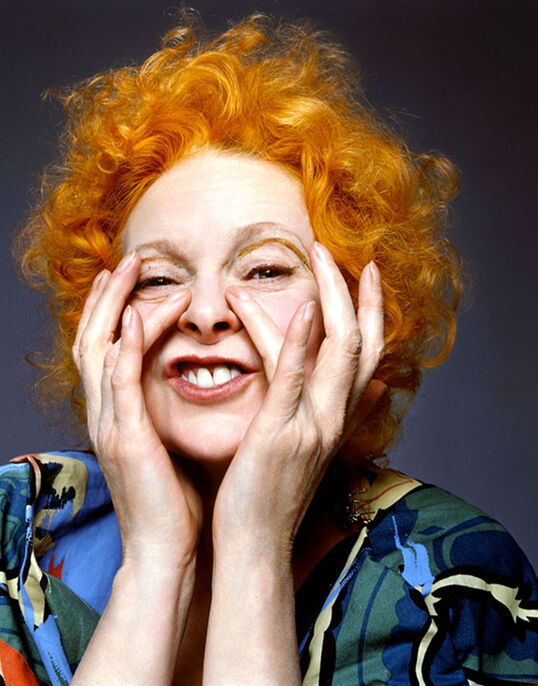
Exploration
2000 – 2016
The exhibition ‘Vivienne Westwood: the collection of Romilly McAlpine’ opens at the Museum of London from April to June 2000.
The official e-commerce website www.viviennewestwood.com launches in 2001.
In 2002, Vivienne Westwood opens a boutique in Hong Kong and two in Korea.
Vivienne receives the UK Fashion Export Award for Design in June 2003.
In Autumn-Winter 2002/03, the Vivienne Westwood X Commes des Garçons collaboration launches in Japan and Milan through the Cosa Coma Comme shops.
Aoyama, the Japanese Vivienne Westwood womenswear flagship boutique opens in March 2003.
In 2003, the house collaborates with the English fine china, porcelain, and luxury accessories manufacturer Calport for the Westwood Home Collection.
A new Vivienne Westwood flagship boutique opens up in Milan, Italy in 2003.
In 2004 the Victoria and Albert Museum hosts a retrospective exhibition celebrating Vivienne Westwood’s contribution to fashion. This was their first exhibition of its kind.
Moet & Chandon Fashion Tribute honours Vivienne Westwood as the first fashion designer to have a solo exhibition at the V&A.
Vivienne Westwood begins a long-term collaboration with The Rug Company designing rugs and cushions in 2005.
Vivienne visits Buckingham Palace for a second time to meet his royal highness Prince Charles, the Prince of Wales to accept her Damehood in 2006.
Vivienne receives the Outstanding Achievement in Fashion Design award at the 2007 British Fashion Awards.
Omotesando, a Japanese Vivienne Westwood menswear flagship boutique, opens in October 2008.
Vivienne receives the Prince Philip Designers Prize in 2010.
The Made in Kenya collaboration launches in 2010, as a partnership with the United Nations in support of the Ethical Fashion Initiative and Artisan Fashion.
Climate Revolution, Vivienne’s activist team and website launches in 2010.
The Vivienne Westwood Los Angeles flagship boutique opens its doors in 2011.
Vivienne donates a million pounds to the charity Cool Earth in 2012.
The first Vivienne Westwood cafe opens in Shanghai in April 2015.
A second Vivienne Westwood cafe opens in Hong Kong’s Harbour City Mall in October 2015.
Vivienne launches her ‘Playing Cards’ in 2017.
Collections:
Summertime, Spring-Summer 2000 – Final collection of the 20th century. – Symbolism of Bacchus, Roman god of agriculture, wine, and fertility. – Inspired by: Bacchanalia. – Pixelated print of fellatio. – Muted colours and florals. – Bestial shoes. – Tailored drapery. – The ‘Booze’ jacket. – Grass stains and red wine spillage. – Wool mélange.
Winter, Autumn-Winter 2000/01 – Inspired by: Shakespeare’s ‘Love’s Labour’s Lost’. – Cloaks with hoods in fringed wool. – Weighty trompe l’œil jewellery in silver. – Soft jerseys. – Tracey Emin. – 16th and 17th centuries.
Exploration, Spring-Summer 2001 – Ode to literature. – “Reading is the biggest passion of my life, more than fashion” (Vivienne). – Aristotle, Aldous Huxley, and Bertrand Russel. – Photographic ‘Bookbinder’ print of Andreas and Vivienne’s bookshelves in Clapham. – Studies of butterflies and insects. – Folded rectangles of cloth like the pages of a book. – Soft tailoring. – Mocking the pipe-smoking intelligentsia.
Wild Beauty, Autumn-Winter 2001/02 – Cora Corré’s (Vivienne’s granddaughter) first appearance on the catwalk at 3 years old. – Mini kilts. – Tiger stripes. – ‘Animal’ cut. – Curved seams and jigsaw pieces like animal hide. – Crushing silk taffeta to create folds and creases. – Embroideries. – Sexual misbehavior.
Nymphs, Spring-Summer 2002 – Fragonard, Boucher and Watteau. – Mythological pastoral idylls. – Long feathered eyelashes. – Traditional striped rugby jerseys. – Angular construction. – Intentional unevenness. – “It’s incredibly lively-looking and nervous-looking” (Vivienne). – Giant corsages. – Models emerged from the foliage.
Anglophilia, Autumn-Winter 2002/03 – Second step from Anglomania. – Vivienne’s favourite red dress. – Queen Elizabeth II’s Silver Jubilee. – Unfinished and undone. – Inspired by: Holbein and Boucher. – Fetishising Englishness. – Snagged argyll knits. – Madame de Pompadour gown. – Subdued palette. – Ribbons and tweeds.
Street Theatre, Spring-Summer 2003 – Fashion as an everyday spectacle and performance. – Rooted in punk. – The urban jungle. – Strapped and restrained. – Union Jacks. – Deliberate destruction. – Relaxed fits. – Geometric sections cut at different angles. – Reversible fine wool.
Le Flou Taille, Autumn-Winter 2003/04 – Fluidity. – Haute couture, tailoring and flou. – “The clothes look very spontaneous but they are incredibly well constructed underneath” (Vivienne for Vogue). – Daytime pyjamas. – Knee-high cossack boots. – Slip and slide. – Satin boxer shorts.
I Am Expensiv, Spring-Summer 2007 – Using Disney characters as a universal expression. – “Endearing heroines and repulsive baddies” (Vivienne). – Block colours. – Exploring the 21st-century obsession with wealth accumulation. – Cut-out lace. – Inspired by: Bowes Museum in Northumberland.
Wake Up Cave Girl!, Autumn-Winter 2007 – Hyper exaggeration of the female form. – “A sculpture in cloth” (Vivienne). – The Stone Age. – Dresses are named after the Flintstones. – Foundation corsets. – Carrie’s taffeta wedding dress in ‘Sex and the City’. – Customizable buttoned seams.
56, Spring-Summer 2008 – July 2007, British government proposed counter-terrorism legislation to imprison people without trial for 56 days, double the existing 28-day period. – Inspired by: 17th century ladies and prostitutes. – “What if Marilyn Monroe married an English lord with a country estate and they had a kinky relationship!” (Vivienne) – The prototype woman. – Pagan ritual. – Abstract graphics.
Chaos Point, Autumn-Winter 2008 – Primary school collaboration. – Freedom fighters in the jungle. – Symbols of CHAOS and Active Resistance. – The ecological crisis is reaching a tipping point. – Childish innocence. – Cut out paper dolls. – Theatrical and magical.
Do It Yourself, Spring-Summer 2009 – “In these hard times – Dress up. Do it yourself!” (Vivienne). – Tablecloths, safety pins, and curtains. – ‘Make Do and Mend’ ethos. – The wonders of drapery. – Signature corsets. – Recycling.
+5°, Autumn-Winter 2009/10 – Inspired by: colour and techniques of painter Andrea Mantegna. – Burnt orange, red and blue. – Renaissance armour translated into knitwear. – Pamela Anderson. – Ecological ‘Gaia’ hypothesis of James Lovelock. – Gaia. – Titled after scientific assertions that climate change would alter global temperatures to a new equilibrium, with catastrophic consequences.
Get a Life, Spring-Summer 2010 – Vivienne’s activism uniform. – Conservation. – Bleached stripes. – Lovelock’s ecological theories part two. – Plastic sleeves. – Powdered faces and high teased pompadours. – Hair up in flames. – Shredded ribbons. – Full skirts.
Prince Charming, Autumn-Winter 2010/11 – The ‘Principle Boy’ in pantomime. – Gender blurring. – “The kind of people you could meet in the Black Forest of Grimm’s Fairy Tales” (Vivienne). – Pencilled-on mustachios. – In solidarity with Marlene Dietrich.
Gaia The Only One, Spring-Summer 2011 – Dedicated to the curvaceous, the voluptuous, and the hyper-feminine. – Themes included Matisse, Commedia dell’arte and ballet. – Tutankhamun, Noh theatre, and little girls on the mountains in Peru, ‘waiting to marry the sun’. – Heart dresses. – Tutus and lampshade skirts.
World Wide Woman, Autumn-Winter 2011/12 – Female agency and power. – Mother Earth. – “It is women who forge the bonds of society” (Vivienne). – Golden brocade woven with faces of medieval icons. – Byzantine jewellery. – Tailoring as armour. – “They are the guardians of culture, most importantly in their creation of the salon (Napoleon agreed to ennoble his generals on condition that their wives opened a salon)” (Vivienne).
War and Peace, Spring-Summer 2012 – Confucianism. – Inspired by: Chinese and Tuareg dress. – Oversized historical corsets. – Tweed as armour. – Audience received a ‘family tree’ connecting Earth and science. – Progress and quality.
London, Autumn-Winter 2012/13 – 17th Century. – “I rely on historical reference. By engaging with human genius I have tried to capture the past in my fashion” (Vivienne). – The connection between theatre and everyday dress. – Andreas’ love for the city. – Unfinished hems. – Children’s drawings.
Climate Revolution, Spring-Summer 2013 – Inspired by: the articulation and colours of beatles. – Paintings of Velazquez. – Pattern found on a Chinese tea box. – Squiggle print. – Clomper shoes. – Waste reduction techniques. – ‘Square’ t-shirts and dresses. – Kate Moss campaign. – London 2012 Paralympic closing ceremony.
Save the Arctic, Autumn-Winter 2013/14 – Medieval Europe. – “I believe that designers always create a virtual reality: the(y) create clothes for a place that does not exist, somewhere better” (Vivienne). – Looking at 14th century illuminated manuscripts. – Models as illustrations. – Taffeta capes.
Everything is Connected, Spring-Summer 2014 – Shakespeare’s ‘Measure for Measure’. – Pilgrimage sandals. – Splattered mud. – Embroideries made from recycled sunglass lenses. – Frida Kahlo iconography references. – Tulle.
Save the Rainforest, Autumn-Winter 2014/15 – An homage to Charles Frederick Worth, the founder of haute couture. – Franz Xaver Winterhalter’s 1865 portrait of Empress Elizabeth of Austria. – Frilled capes. – Military fatigue. – Anti-fracking slogans.
Unisex – Time to Act, Autumn-Winter 2015/16 – ‘Bisexual’ looks. – A male, chest-baring ‘Westwood Bride’. – Soft and fluid versus heft and structure. – English hand-tailoring. – Playing with proportion. ‘It’s so sexual because it’s new. It makes you look at the person from the outside’ (Vivienne).
Mirror the World, Spring-Summer 2016 – Venice of the Renaissance. – Bellini, Giorgione and Titian. – 15th Century Murano mirror-manufacturing. – Pagan origins of Venice Carnival. – Jackets suspended on structures above models’ heads referencing the stilt-supported Palazzos. – Belle Epoque hats. – Final Gold Label show.
“I formed Climate Revolution: to save the environment through work with charities and NGOs. Our target is to speak with one voice. As an activist, I have created many graphics promoting political and environmental issues, which I reimagined in the design of a pack of playing cards. Lo and behold! In the cards lies the answer — a complete strategy to save the world: Buy less, stop subsidies to industrial fishing, educate children, and so on. We even have a manifesto, detailing our need to move away from capitalism toward what I call “No Man’s Land” — a vision for the world based on the principle that no one should be allowed to own land.”
— Vivienne Westwood
Beginning to put historicism to one side, Vivienne returned to a more asexual cut, exploring the natural dynamic of the fabric by treating it like a living, breathing mass. Inspired by James Lovelock’s ‘Gaia hypothesis’, which suggests life on Earth is a self-regulating community of organisms interacting with each other and their surroundings. Vivienne started looking at her environment and reflecting on the world around us and the worlds that came before. Activism became her number one priority, she started using her collections as a vehicle for change. Encouraging consumers to analyse and react to the climate crisis. She began using her clothes like a megaphone, a political warning that tells a story of a complex past and future fear.
“The map is by NASA, it’s geothermal and coincides with the New Scientist map. I simply drew along the line of division and marked off below the line as uninhabitable; above it: all that was left. This is public information, it’s my job now to get people to internalise it. We’re already at around 2 degrees. 2 degrees is cited as the tipping point for runaway climate change and it won’t stop until it reaches around 5 degrees. At this point, according to the map, there will only be 1 billion people left, this is inevitable and it could happen by the end of the century.”
— Vivienne Westwood
Andreas Kronthaler for Vivienne Westwood
2016 – Present
The Vivienne Westwood New York and Paris flagship boutiques open their doors in 2016.
The Ginza Six flagship boutique opens in Japan in April 2017, with the same concept as Paris.
In 2018, the Vivienne Westwood collaboration with Burberry launches, in joint support of UK-based non-profit Cool Earth, who raise money to help protect the endangered rainforests, combat global warming, protect ecosystems and provide employment for local people.
A flagship boutique on Patterson Street in Hong Kong opens in November 2018.
The Asics X Vivienne Westwood three-year collaboration launches in April 2019.
The Vivienne Westwood X Vans Anglomania capsule collection launches in September 2019.
The Vivienne Westwood X Buffalo collaboration launches in May 2019.
The Vivienne Westwood X Eastpak ‘SAVE OUR OCEANS’ collection of bags and accessories launches in July 2020.
Vivienne Westwood partners with environmental not-for-profit Canopy for 2020 World Earth Day in their campaign to protect forests through fabric choices.
Both the Vivienne Westwood Shanghai and Beijing Flagship boutiques open in December 2021.
The last physical Vivienne Westwood mainline show took place at Autumn-Winter 2019 London Fashion Week. From then on it was decided to go digital, for environmental reasons.
Paris Fashion Week Autumn-Winter 2016 marked a new and exciting chapter for the house. Vivienne’s long-term husband Andreas Kronthaler debuted his first official collection there, under the name Andreas Kronthaler For Vivienne Westwood, replacing Gold Label forevermore. Vivienne Westwood mainline continues to produce bi-annual collections, shown separately.
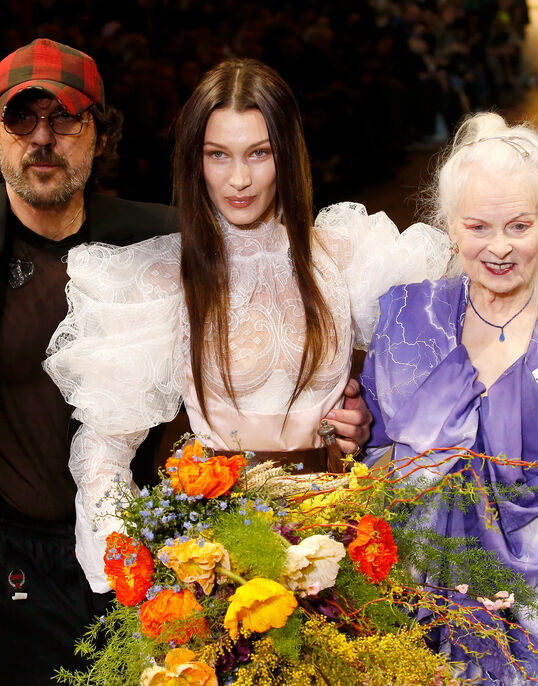
“I have designed with Vivienne for more than 25 years. To add my name is to emphasise and clarify the differences between our lines. It is not a big change to the way we work but it will bring a new direction and I am happy and excited for the future.”
— Andreas Kronthaler
“Over the years Andreas has taken on ever more responsibility and I wish this fact to be reflected in public perception.”
— Vivienne Westwood
“We chose to separate our lines in order to clarify and reduce them. Gold Label became Andreas Kronthaler for Vivienne Westwood, while Vivienne designs Vivienne Westwood Mainline, which includes Unisex – a way to reduce buying.”
— Andreas Kronthaler



